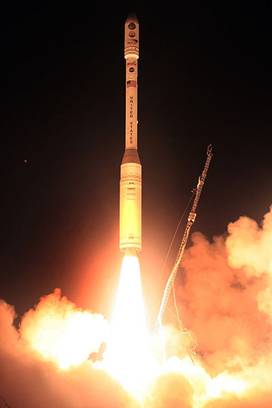25 February 2009

The unsuccessful launch of OCO
Credit: NASA
On 24 February 2009, NASA’s Orbiting Carbon Observatory (OCO) satellite failed to reach orbit, due to a rocket malfunction. This was the first mission dedicated to provide global space-based measurements of atmospheric carbon dioxide (CO2), to help pinpoint the locations where CO2 is released and absorbed.
The launch occurred aboard the Taurus XL rocket. NASA officials said the fairing, the part of the rocket carrying the satellite, failed to separate during ascent. The added mass of the fairing prevented the satellite from reaching orbit. It subsequently re-entered the atmosphere and crashed into the Indian Ocean, near Antarctica. NASA will form a Mishap Investigation Board to determine the cause of the launch failure.
CO2 is a critical constituent of Earth's atmosphere. Since the beginning of the industrial age, the concentration of CO2 has increased by about 38%, from about 280 parts per million to over 380 parts per million. Studies show that CO2 is one of several gases that trap heat near Earth’s surface. These gases are known as greenhouse gases.
Many scientists have concluded that substantial increases in the abundance of CO2 will lead to an increase in Earth's surface temperature. Historical records provide evidence of this phenomenon, which is often called global warming. Current research indicates that continuing increases in atmospheric CO2 may alter the environment in a variety of ways. These changes may impact global phenomena, including the ocean currents, the jet stream and rain patterns. Some parts of Earth might actually cool while the average temperature increases. Thus, a more correct term for this phenomenon is climate change.
The CO2 emission into the atmosphere may come from various sources. Some sources are natural, such as rotting plants, forest fires and ordinary breathing. Human activities augment the emission of CO2 into the atmosphere. The burning of fossil fuels, such as oil and coal, releases CO2 into the atmosphere.
Some natural processes absorb CO2 from the atmosphere. In photosynthesis, plants use sunlight to produce sugar and other carbohydrates from CO2. The oceans also absorb atmospheric CO2.
Sea creatures incorporate the CO2 dissolved in sea water into their shells. After these creatures die, their shells fall to the bottom of the ocean. Over time, these sediments form carbonate rocks. Processes that absorb CO2 from the atmosphere are referred to as sinks. The complete process of CO2 exchange is termed the carbon cycle.
Further Reading
OCO Website
http://oco.jpl.nasa.gov/mission/
Aymen Mohamed Ibrahem
Senior Astronomy Specialist